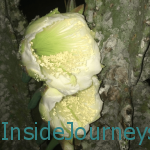I thought it quite an achievement when I caught the once yearly flowering of the night-blooming cereus last year. I had experienced a phenomenon many flower lovers would probably give a vital body part to see.
Visiting a family friend over the weekend, I noticed several unopened buds on a cactus on the periphery of their property. How unusual, I thought to myself. You should get a photo. But I returned my attention to the people with whom I was speaking, people I hadn’t seen in a while.
During a lull in the evening’s activities, I looked over and saw that flowers had replaced the buds I had seen earlier. I didn’t have my camera so I grabbed my phone and practically dragged my cousin, an award-winning flower lover, over to where the night-blooming cactus was. She had seen it too and told me after that she planned to ask our family friend for a cutting.

(Jamaican women are passionate about their gardens and will willingly trade cuttings with friends and other flower lovers. So you’ll see the same flowers in the gardens of women who are friends.)
The flowers looked similar to the cereus I had seen last year. It was surprising to me then I remembered that the cereus is from the flowering cactus family.
Here’s a photo of the night-blooming cereus for comparison.

While the night-blooming cereus lasts only one night, this genus of the night-blooming cactus lasts two. Both attract a special moth that causes them to pollinate.
As I write this I realize that one thing was different — the cactus didn’t have the subtle fragrance that accompanied the cereus. But it had rained, no poured, that evening so the rain could have washed away the scent.
Have you seen a night-blooming cactus?
This week, I’m linking this post to Budget Traveler’s Sandbox and Travel Photo Monday. Be sure to check out the other photos that are posted there.










